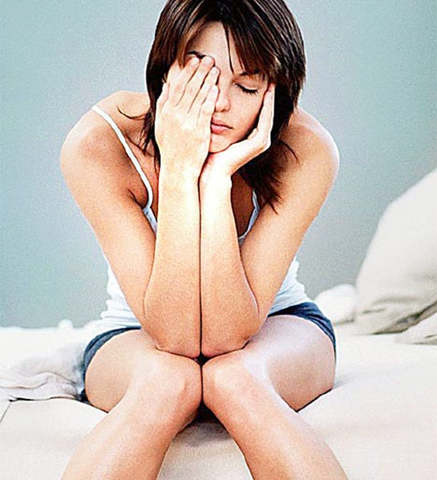The age of adolescence is a very delicate time in a girl’s life. The body has to get used to lots of physical & mental changes; it is the transition of a young girl into a woman of the future. A smooth sailing through these years ensures that the woman emerges into a confident future of tomorrow. Hence it becomes very important that this time is free of any pain or discomfort of any sort. One of the major complaints young girls face is menstrual cramps or in medical terminology Dysmenorrhea. Let us know something more about this common ailment.
What are Menstrual Cramps?
- Menstrual cramps are pains in the belly and pelvic areas that are experienced by a woman as a result of her menstrual period.
- Menstrual cramps are not the same as the discomfort felt during Premenstrual syndrome (PMS), although the symptoms of both disorders can sometimes be experienced as a continual process. Many women suffer from both PMS and menstrual cramps.
- Menstrual cramps can range from mild to quite severe. Mild menstrual cramps may be barely noticeable and of short duration sometimes felt just as a sense of light heaviness in the belly. Severe menstrual cramps can be so painful that they interfere with a woman’s regular activities for several days.
- Menstrual cramps of some degree affect more than an estimated 50% of women, and among these, up to 15% would describe their menstrual cramps as severe.
- Surveys show that over 90% of girls report having menstrual cramps.
- The medical term for menstrual cramps is dysmenorrhea. There are two types of dysmenorrhea, primary and secondary.
- In primary dysmenorrhea, there is no underlying gynecologic problem causing the pain. This type of cramping may begin within six months to a year following menarche (the beginning of menstruation).
- In secondary dysmenorrhea, some underlying abnormal condition (usually involving a woman’s reproductive system) contributes to menstrual pain. Secondary dysmenorrhea may be evident at menarche but, more often, the condition develops later.
Causes of Menstrual Cramps
Each month, the inner lining of the uterus normally builds up in preparation for a possible pregnancy. After ovulation, if the egg is not fertilized by a sperm, no pregnancy will result and the current lining of the uterus is no longer needed. The woman’s estrogen and progesterone hormone levels decline, and the lining of the uterus becomes swollen and is eventually shed as the menstrual flow is replaced by a new lining in the next monthly cycle.
When the old uterine lining begins to break down, molecular compounds called prostaglandins are released. These compounds cause the muscles of the uterus to contract. When the uterine muscles contract, they constrict the blood supply (vasoconstriction) to the endometrium. This contraction blocks the delivery of oxygen to the tissue of the endometrium which, in turn, breaks down and dies. After the death of this tissue, the uterine contractions literally squeeze the old endometrial tissue through the cervix and out of the body by way of the vagina.
Menstrual cramps are caused by these uterine contractions that occur in response to prostaglandins and other chemicals. The cramping sensation is intensified when clots or pieces of bloody tissue from the lining of the uterus pass through the cervix, especially if a woman’s cervical canal is narrow.
The difference between menstrual cramps that are more painful and those that are less painful may be related to a woman’s prostaglandin levels. Women with menstrual cramps have elevated levels of prostaglandins in the endometrium (uterine lining) when compared with women who do not experience cramps. Menstrual cramps are very similar to those a pregnant woman experiences when she is given prostaglandin as a medication to induce labor.
Other Factors Influencing Menstrual Cramps
- As mentioned above, an unusually narrow cervical canal tends to increase menstrual cramps.
- Another anatomical factor thought to contribute to menstrual cramps is a backward tilting of the uterus (a retroverted uterus).
- Lack of exercise is now recognized to contribute to painful menstrual cramps.
It has long been thought that psychological factors also play a role. For example, it is widely accepted that emotional stress can increase the discomfort of menstrual cramps.
Other Factors Influencing Menstrual Cramps
- Menstrual cramps have pains that begin in the lower abdomen and pelvis. The discomfort can extend to the lower back or legs. The cramps can be quite painful or simply a dull ache. They can be periodic or continual.
- Menstrual cramps usually start shortly before the menstrual period, peak within 24 hours after the onset of the bleeding, and subside again after a day or two.
- Menstrual cramps may be accompanied by headache and/or nausea, which can lead, although infrequently, to the point of vomiting.
- Menstrual cramps can also be accompanied by either constipation or diarrhea because the prostaglandins which cause smooth muscles to contract are found in both the uterus and intestinal tract.
- Some women experience an urge to urinate more frequently.
Homeopathic Help for Dysmenorrhea
As we know that homeopathy takes into consideration the whole person & not just their complaints. Our medicines are of great help in menstrual cramps in all age groups of women & we also take note of their lifestyle, their profession, regular routine habits & if there is any underlying cause in severe cases.
Excellent remedies like Caulophyllum & Cimicifuga act on the uterine muscles & give relief to the woman.
Mental irritability, anger & mood swings along with severe cramps are well covered by Chamomilla & Pulsatilla.
Frequent doses of Magnesium phos act as muscle relaxant & gives relief from pain.
As homeopathy is safe from all angles it can be given to young girls & they are saved from taking strong painkillers which may cause other side effects.

